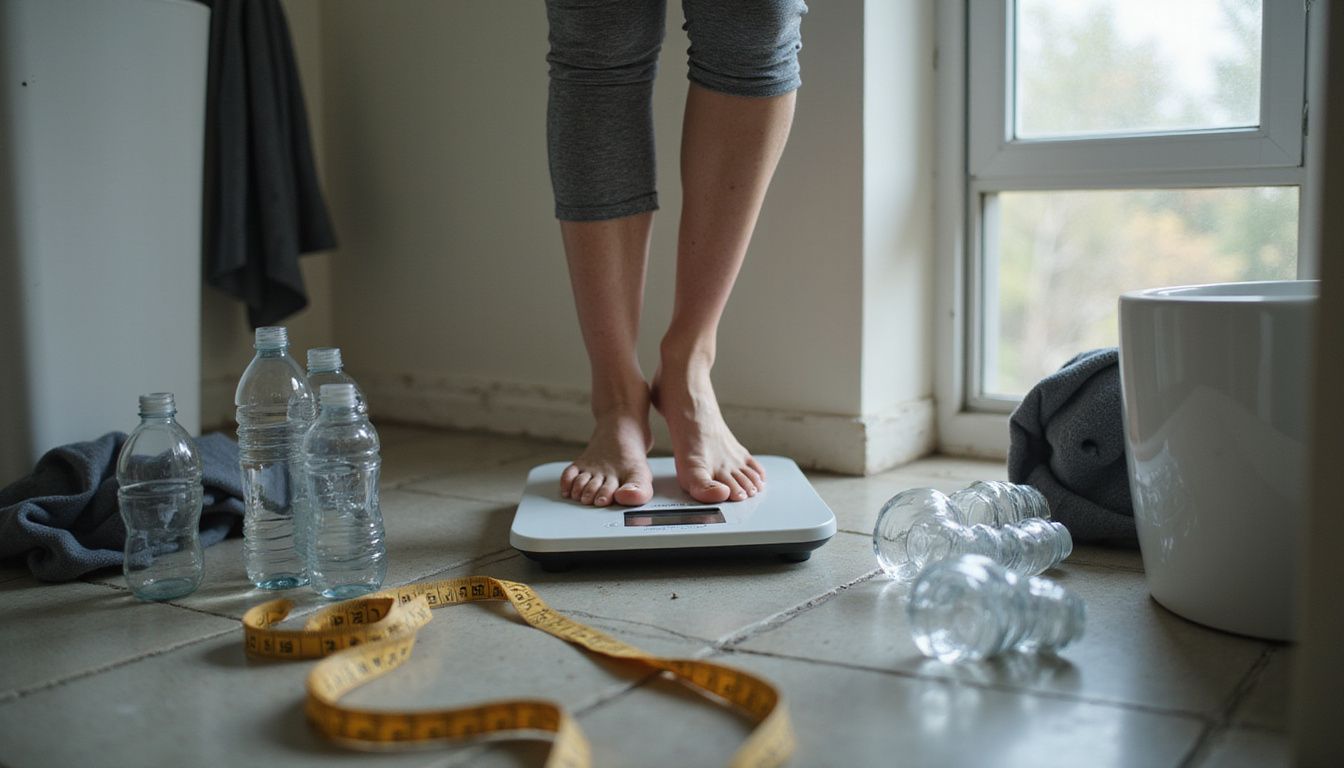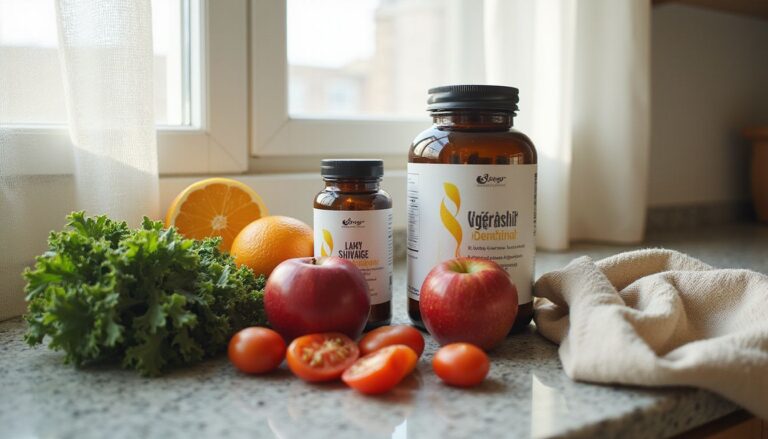Efficient 10 Kg Weight Loss In 7 Days Diet Plan – Your Ultimate Meal Plan For Rapid Results
Our Nutrition Assistant AI Suite will transform your body. You will lose fat, get toned, and build muscle. Gain confidence and optimal health.
Trying to lose weight fast can feel stressful. A strict diet plan promises quick results, yet safety and sustainability matter most. This guide shows how a balanced meal plan, smart calorie control, and daily activity can speed up progress without ignoring your health.
You will learn simple steps you can follow for one focused week. The plan uses high protein, plenty of fiber, and steady hydration to support rapid weight loss. Read on for practical tips, clear meals, and ways to protect your body along the way.
Key Takeaways
- Losing 10 kg in 7 days needs very low calories and daily exercise; most health experts consider this unsafe without medical supervision.
- Much of the early loss is water and muscle, not body fat, which raises risks like fatigue, gallstones, and fast regain after the diet ends.
- Clinicians recommend a safer pace of 0.5 to 1 kg per week; follow extreme plans only with guidance from a licensed clinician or a registered dietitian.
- Protein and fiber help control hunger and support muscle during calorie restriction, but lasting results require long-term habit change.
- Track calories, drink at least 2 liters of water daily, and combine cardio with strength training to boost short-term results while guarding your health.

What Does Losing 10 Kg in 7 Days Mean?

Dropping 10 kilograms in a single week demands severe changes in calorie intake and daily habits. Such rapid weight loss often shifts hydration and metabolism, which can affect how your body uses energy.
What Does Losing 10 Kg in 7 Days Mean?
Ten kilograms equals about 22 pounds. Achieving that in seven days requires a very strict diet plan with major cuts in calories and big changes in eating patterns. Programs like the GM diet plan attract people who want fast results for a short deadline.
Most of the rapid loss is water and some lean muscle rather than pure fat. Health authorities advise a slower pace, usually 1 to 2 pounds each week. Rapid plans might serve as a short jumpstart, yet they rarely solve long-term weight management alone.
Many people regain quickly because old habits return. If you consider this path, weigh the risks and be ready to shift to balanced eating and regular physical activity after the week ends.
Is Rapid Weight Loss Safe?
A goal of 10 kg in 7 days can harm more than help. Losing more than 0.5 to 1 kg per week is usually unsafe for most people, according to public health guidance.
Extreme calorie cuts can trigger stress hormones, lower metabolism, and make future loss harder. You may lose water and muscle instead of fat, raising the risk of fatigue, constipation, diarrhea, gallstones, gout flares, nausea, and heart issues.
Children, teens, pregnant people, and older adults should avoid drastic diets unless supervised by a clinician or a registered dietitian.
Most people who follow crash diets regain the weight within weeks.
Loss of muscle lowers your daily calorie burn, which can promote regain. If you still plan a very short program, talk with a licensed healthcare professional first.
Key Principles of the 7-Day Weight Loss Plan
A focused 7-day plan works best when you understand the basics. Think of it as a short sprint that still requires smart pacing and safeguards.
How Does a Calorie Deficit Help You Lose Weight?
A calorie deficit means you eat fewer calories than you burn. Your body then uses stored energy, which helps reduce body fat over time.
- Common targets: 1,200 to 1,500 calories per day for many women, and 1,500 to 1,800 for many men.
- Very low-calorie diets near 800 calories may cause faster loss, yet they carry higher risks and should be medically supervised.
Tracking intake and portions makes progress measurable. I saw steady loss when I focused on nutrient-dense foods and portion control, without feeling deprived.
Why Is Hydration Important for Weight Loss?
Water supports digestion, energy, and exercise performance. It can also help you feel full so you eat fewer calories at meals or snacks.
- Drink about 2 liters, or 8 cups, per day to support fullness and stable blood sugar.
- Replace fluids lost in workouts to prevent dehydration and keep your metabolism active.
Having a glass of water before meals can help you control portions during this 7-day diet plan.
What Does Balanced Nutrition Look Like?
Balanced nutrition means eating a mix of protein, fiber, healthy fats, and complex carbs. This variety supports fullness and stable energy.
- Protein: eggs, yogurt, chicken breast, beans, and tofu to support muscle.
- Fiber: vegetables and fruits for vitamins, minerals, and digestive health.
- Whole grains: oats and brown rice for steady energy.
- Healthy fats: avocado and nut butters to aid hormone balance and brain function.
- Limit refined carbs: white bread, sweets, and sugary drinks can spike blood sugar and hunger.
Build plates with half vegetables, one quarter protein, and one quarter whole grains. This simple rule helps whether you eat meat or follow a vegetarian diet.
How Can Physical Activity Boost Your Weight Loss?
Daily movement helps you burn more calories and preserve muscle. Cardio, like brisk walking or cycling, increases daily burn. Strength training builds muscle, which raises resting metabolism, meaning you burn more even at rest.
Try 30 minutes of walking or jogging one day, then light weights the next. When I added short daily workouts to my meal plan, the scale moved faster and energy stayed steady.
The Detailed 7-Day Diet Plan
This 7-day diet plan outlines meals that support rapid progress. Follow the structure closely, then be ready to transition to a sustainable plan.
Day 1: Fruit-Only Diet
Focus on hydrating fruits like apples, berries, oranges, and melons. Baked Banana-Nut Oatmeal Cups make a good breakfast at about 271 calories. Add a medium apple for extra fiber. A clementine for a snack adds only 35 calories.
Approximate totals: 1,203 calories, 66 g protein, 177 g carbohydrate, and 34 g fiber. Drink plenty of water or unsweetened tea.
Day 2: Vegetable-Only Diet
Fill your plate with carrots, potatoes, cauliflower, zucchini, and tomatoes. For lunch, consider Chipotle-Lime Cauliflower Taco Bowls at about 344 calories. For dinner, Zucchini-Chickpea Veggie Burgers with Tahini-Ranch Sauce at about 373 calories.
Approximate totals: 1,215 calories, 45 g protein, 158 g carbohydrate, 30 g fiber, and about 1,488 mg sodium. Vegetables have a low glycemic index, which can help keep blood sugar steadier.
Day 3: Mixed Fruits and Vegetables
Combine fruits and vegetables for variety and more antioxidants. A snack of two clementines is about 70 calories. Mix raw and lightly cooked produce like spinach, cucumbers, carrots, tomatoes, blueberries, and apples.
Try Easy Salmon Cakes over two cups of baby spinach for dinner, about 401 calories and solid protein. Daily totals near 1,190 calories, 59 g protein, 176 g carbohydrate, and 35 g fiber with about 1,534 mg sodium.
I felt fuller between meals when I paired salads with simple fruit bowls, which reduced cravings for sweets.
Day 4: Bananas and Milk Diet
Eat up to eight small or six large bananas with three glasses of skim milk. Bananas provide potassium and vitamin B6. Milk adds calcium and protein to help protect muscle during this strict day.
This combination is simple to follow and gentle on digestion. Skip calorie-dense extras like cheese or high-fat meats to keep the deficit working.
Day 5: Protein-Rich Diet (Meat or Alternatives)
Increase protein with eggs, fish, chicken breast, lean beef, tofu, or beans. Start with a hard-boiled egg. An AM snack of 1/2 oz Cheddar adds about 135 calories for the pair.
Spinach Ravioli with Artichokes and Olives at dinner provides about 454 calories. Daily totals near 1,220 calories and about 51 g protein. Protein increases fullness, which can reduce late-night snacking.
Day 6: Protein and Vegetables
Pair protein-rich foods with fibrous vegetables. A veggie and hummus sandwich at lunch is about 325 calories. Dinner could be Curried Sweet Potato and Peanut Soup with a small slice of whole-wheat baguette, about 405 calories.
Totals near 1,190 calories, 47 g protein, 168 g carbohydrate, 38 g fiber, 46 g fat, and about 1,281 mg sodium. On weeks I used similar meals with beans and hummus, I felt satisfied without sluggishness.
Day 7: Brown Rice, Fruits, and Vegetable Juice
Choose brown rice for steady energy. Add fruits like raspberries for fiber and antioxidants. A PM snack of one cup raspberries at about 65 calories plus one ounce of dark chocolate can satisfy a sweet craving.
Spinach and Artichoke Dip Pasta adds variety at about 371 calories. Aim for about 1,221 calories total to maintain the calorie deficit. Then prepare to shift to a sustainable eating pattern.
What Are Some Sample Meals for Each Day?
Here are flexible options that match the plan. Pick the choices that fit your tastes and calorie target for the day.
What Are Healthy Breakfast Ideas?
Choose whole foods and control portions. Good options include:
- Baked Banana-Nut Oatmeal Cups, about 271 calories.
- Muesli with raspberries, about 287 calories.
- Egg in a Hole Peppers with Avocado Salsa, about 285 calories.
- Greek yogurt with berries for protein and probiotics.
Muesli kept my energy steadier than sugary cereals, which helped limit midday cravings during lower-calorie weeks.
What Are Nutritious Lunch Ideas?
Lunch should be filling and balanced. Try a veggie and hummus sandwich at 325 calories or Chipotle-Lime Cauliflower Taco Bowls at 344 calories. Grilled chicken salad adds lean protein with few extra calories.
Chicken and cucumber lettuce wraps with peanut sauce are about 521 calories per serving. Meals high in protein and fiber help control hunger and support muscle, especially during rapid plans.
What Are Balanced Dinner Ideas?
Dinner should continue the balance of protein, fiber, and whole grains.
- Sheet-Pan Chicken Fajita Bowls with 1/2 cup cooked brown rice, about 468 calories.
- Zucchini-Chickpea Veggie Burgers with Tahini-Ranch Sauce, about 373 calories.
- Easy Salmon Cakes over two cups baby spinach, about 401 calories.
- Spinach Ravioli with Artichokes and Olives, about 454 calories.
- Curried Sweet Potato and Peanut Soup with whole-wheat baguette, about 405 calories.
- Spinach and Artichoke Dip Pasta, about 371 calories.
These meals deliver protein, fiber, and healthy fats with moderate complex carbs, which can help reduce night snacking.
What Are Good Healthy Snack Options?
Snacks can steady energy and prevent overeating later. Consider these:
- One clementine, about 35 calories.
- One medium banana, about 105 calories.
- Half cup raspberries, about 32 calories.
- One hard-boiled egg, about 77 calories.
- One ounce Cheddar, about 115 calories.
- One ounce dark chocolate, fits well on Day 7.
- Unsalted roasted almonds, measure portions to manage calories.
Pick snacks with protein or fiber, like eggs or nuts, since they reduce hunger longer than refined carbohydrates.
How Can You Maximize Your Weight Loss Results?
Small, steady habits drive progress. Use tools and simple routines to keep the plan on track.
How Do You Track Your Calorie Intake?
Write down everything you eat and drink. A food diary or a phone app, such as MyFitnessPal, helps you log meals, snacks, and drinks with better accuracy.
- Set a daily calorie limit, for example 1,200 calories, and add items until you reach it.
- Weigh ingredients for homemade meals and check labels for serving sizes.
Tracking helped me catch hidden calories in sauces and dressings that I used to miss.
Why Increase Protein and Fiber Intake?
Protein supports muscle during calorie restriction. Many people do well at 45 to 66 grams per day on this plan. Fiber slows digestion, helps gut health, and supports fullness.
- Aim for about 30 to 42 grams of fiber daily from vegetables, fruits, legumes, and whole grains.
- Choose protein at each meal to control hunger and protect lean mass.
Adding beans to lunch and eggs to breakfast kept me satisfied between meals during a past 7-day challenge.
How to Reduce Refined Carbohydrates?
Swap refined carbs like white bread and pastries for whole grains. Pick brown rice, oats, or a whole-wheat baguette. Lowering refined carbs reduces blood sugar spikes and can limit cravings.
When I replaced white pasta with quinoa, I stayed full longer and had more stable energy.
What Is Time-Restricted Eating and How to Practice It?
Time-restricted eating means eating within a set window each day. A common approach is 16:8, where you eat for eight hours and fast for sixteen hours.
For example, eat at 10 a.m., 2 p.m., and 6 p.m. Many people find that regular eating windows reduce late-night snacking. Early studies suggest it may support weight control and insulin sensitivity, though long-term results vary.
What Exercise Supports Rapid Weight Loss?
Exercise increases daily burn and helps protect muscle. Think of it as a supportive partner to your meal plan.
What Are Effective Cardio Exercises?
Start with brisk walking for 30 to 45 minutes. Cycling, jogging, or swimming also work well. Try intervals on Day 3, alternating one minute of running with two minutes of walking.
Changing activities across the week can make it easier to stay active and avoid boredom.
How Does Strength Training Help Weight Loss?
Strength work helps you keep muscle while losing fat. Train three times in the week, for example upper body on Day 2, lower body on Day 4, and full body plus core on Day 6.
Three sets of 10 to 12 reps for each exercise is a solid start. I felt stronger and saw better shape when I combined lifting with a calorie deficit, compared with cardio alone.
What Are the Best Fat-Burning Workouts?
High-intensity interval training, called HIIT, mixes short bursts of hard effort with brief rests. It can raise metabolism for hours after a session. For instance, sprint 30 seconds, then walk one minute, and repeat for 20 to 25 minutes.
Full-body circuits using squats, push-ups, lunges, burpees, and planks also burn many calories. Include a 5 to 10 minute warm-up and cool-down, and drink water throughout.
What Are the Benefits of the 7-Day Diet Plan?
Structured meals and activity can bring quick changes. Short programs may also boost motivation for longer goals.
How Does It Promote Quick Weight Reduction?
This plan uses a strict calorie deficit, often near 1,200 calories per day. Very low-calorie diets can produce about 1.5 to 2 kilograms per week in clinical settings, though medical oversight is vital. Protein and fiber increase fullness, which can reduce snacking.
Fruits, vegetables, and lean proteins also reduce water retention for some people. Planning meals ahead made my own week smoother and cut extra bites between meals.
How Does It Improve Digestive Health?
Higher fiber intake, up to about 42 grams per day, supports regularity and feeds healthy gut bacteria. Whole grains, fruits, and vegetables provide both soluble and insoluble fiber, which can reduce bloating and improve comfort.
Apples add soluble fiber and antioxidants. Brown rice on Day 7 brings insoluble fiber to keep things moving.
How Does It Enhance Energy Levels?
Eating on a schedule helps stabilize blood sugar and reduces energy swings. Smaller meals and planned snacks can prevent dips that lead to overeating.
During a similar week, spreading meals across the day kept me clear-headed and active.
What Are the Possible Risks and Precautions?
Fast plans carry risks, especially without guidance. Know the common issues and how to reduce them before you begin.
What Nutritional Deficiencies Might Occur?
Severe calorie restriction can lead to low intake of key nutrients. Vitamins such as B12 and D, and minerals like calcium, iron, potassium, and magnesium may fall short. Very low-protein days can cause weakness. Very low-carb days may reduce fiber and slow digestion.
I once felt dizzy and had headaches after three days on a fad plan that missed several nutrients. Research from public health sources reports many people on restrictive diets develop at least one deficiency within weeks.
How Can Muscle Loss Be Prevented?
Strength train at least three times during the week. Simple bodyweight moves like squats, push-ups, and lunges work well. Include enough daily protein, usually 45 to 66 grams on this plan.
Grilled chicken, fish, tofu, or beans at meals support repair and help protect lean mass while you are in a deficit.
How to Avoid Rebounding Weight Gain?
Rapid loss often leads to regain if habits do not change. Shift to a slower pace after the week ends. Target 0.5 to 1 kilogram per week and keep tracking food and activity.
Choose whole grains, fruits, vegetables, lean proteins, and healthy fats most of the time. Logging dinners helped me hold portions steady for months.
Summary: Use quick plans as a short boost, then commit to steady habits that last.
How Can You Maintain Long-Term Weight Loss Results?
Long-term success depends on daily routines. Simple, repeatable steps beat short bursts of willpower.
How to Transition to a Sustainable Diet?
Slowly raise calories after the 7-day diet plan. Build meals around grilled chicken or fish, brown rice, beans, and many vegetables. During this phase, some people like to combine one meal replacement with two regular meals.
Planning menus each week made my shift easier and prevented impulse snacking. Aim for variety and a balance of protein, fiber, and healthy fats.
Why Is Consistent Exercise Important?
Regular activity burns calories and helps keep them off. The Centers for Disease Control and Prevention suggests at least 150 minutes of moderate cardio each week. Pair that with strength training to protect muscle and raise daily burn.
You do not need complex routines. Mix brisk walks with short resistance sessions at home. When I added brief daily walks during my week, results came faster and energy improved.
How to Establish Healthy Eating Habits?
Combine steady exercise with routine food choices. Pick whole foods most of the time, lean proteins for fullness, and colorful produce for vitamins and minerals. Choose whole grains like brown rice, oats, or quinoa to boost fiber.
Use smaller plates to help manage portions. Drink water through the day to support weight control. Keep simple snacks, like apple slices or yogurt, ready for busy times.
Tracking meals in an app helped me spot hidden calories in sauces and packaged items. New habits can take weeks to stick, so give yourself time.
| Action | Examples |
|---|---|
| Pick whole foods | Fresh fruit, lean meats, beans, tofu |
| Limit portions | Smaller plates, measure servings |
| Stay hydrated | About 8 to 10 cups of water daily |
Sources: CDC on fiber benefits, Harvard T.H. Chan School of Public Health on hydration, and habit formation research in the European Journal of Social Psychology, 2009.
Conclusion
A 7-day meal plan can lead to rapid weight loss, yet it carries risks. This approach often sets calories near 1,200 per day and focuses on protein and fiber to support fullness and muscle. Daily physical activity adds another boost by increasing calorie burn and helping preserve lean mass.
If you feel weak or unwell, increase calories slightly or pause the plan. Children, teens, pregnant people, and older adults should follow only with medical guidance. Expect that losing a full 10 kg in one week is unlikely and unsafe for most people.
Use this strict week as a short reset, then move to a sustainable diet plan with steady exercise. Long-term weight loss comes from consistent habits, not from a single intense week. Consult a clinician or a registered dietitian before starting any very low-calorie plan, especially if you have a medical condition or take prescription medicine.
FAQs
1. Is it safe to lose 10 kilograms in 7 days with a rapid meal plan?
Rapid weight loss, such as losing 10 kilograms in one week, can pose health risks. Medical studies show that most experts recommend losing about 0.5 to 1 kilogram per week for safety and long-term success (CDC, 2022). Extreme diets may cause muscle loss or dehydration rather than true fat reduction.
2. What foods should I include in an efficient diet plan for fast results?
A well-structured meal plan focuses on low-calorie vegetables like spinach and broccoli, lean proteins such as chicken breast or fish fillet, and whole grains including brown rice or oats. These foods provide essential nutrients while keeping calorie intake controlled.
3. Can exercise help support a rapid weight loss of 10 kilograms in seven days?
Physical activity increases calorie burn and supports healthy metabolism during any diet plan. Research from the American College of Sports Medicine suggests combining aerobic activities like brisk walking with strength training helps preserve muscle mass when following a reduced-calorie regimen.
4. Are there risks linked to following an ultimate meal plan promising quick results?
Quick-fix diets often lack important vitamins and minerals needed for body function; this can lead to fatigue, dizziness, or nutrient deficiencies according to Harvard Health Publishing (2021). Personal experience shows sustainable changes work better over time compared to extreme short-term plans.
Summary: Rapid weight loss programs may offer fast results but carry significant health concerns if not managed carefully under professional guidance. Balanced nutrition paired with regular physical activity remains key for lasting progress and overall wellness.







